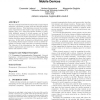5813 search results - page 1005 / 1163 » Hotness-Aware Sensor Networks |
PIMRC
2008
IEEE
14 years 4 months ago
2008
IEEE
— The Internet of Things, emerging pervasive and sensor networks are low data-rate wireless networks with, a priori, no specific topology and no fixed infrastructure. Their pri...
SUTC
2006
IEEE
14 years 4 months ago
2006
IEEE
Security in wireless ad hoc networks is hard to achieve due to the vulnerability of its links, limited physical protection, and the absence of a centralized management point. Cons...
IWCMC
2006
ACM
14 years 4 months ago
2006
ACM
Self-Organized Networks (SONs) are a general description of autonomous networks without infrastructure, of which Ad Hoc, Sensor and Mesh networks are special cases. We had previou...
WMASH
2004
ACM
14 years 3 months ago
2004
ACM
Wireless networked embedded terminals like personal digital assistants, cell-phones or sensor nodes are typically memory constrained devices. This limitation prevents the developm...
INFOCOM
2002
IEEE
14 years 3 months ago
2002
IEEE
Abstract— In [1], Gupta and Kumar determined the capacity of wireless networks under certain assumptions, among them point-to-point coding, which excludes for example multi-acces...

